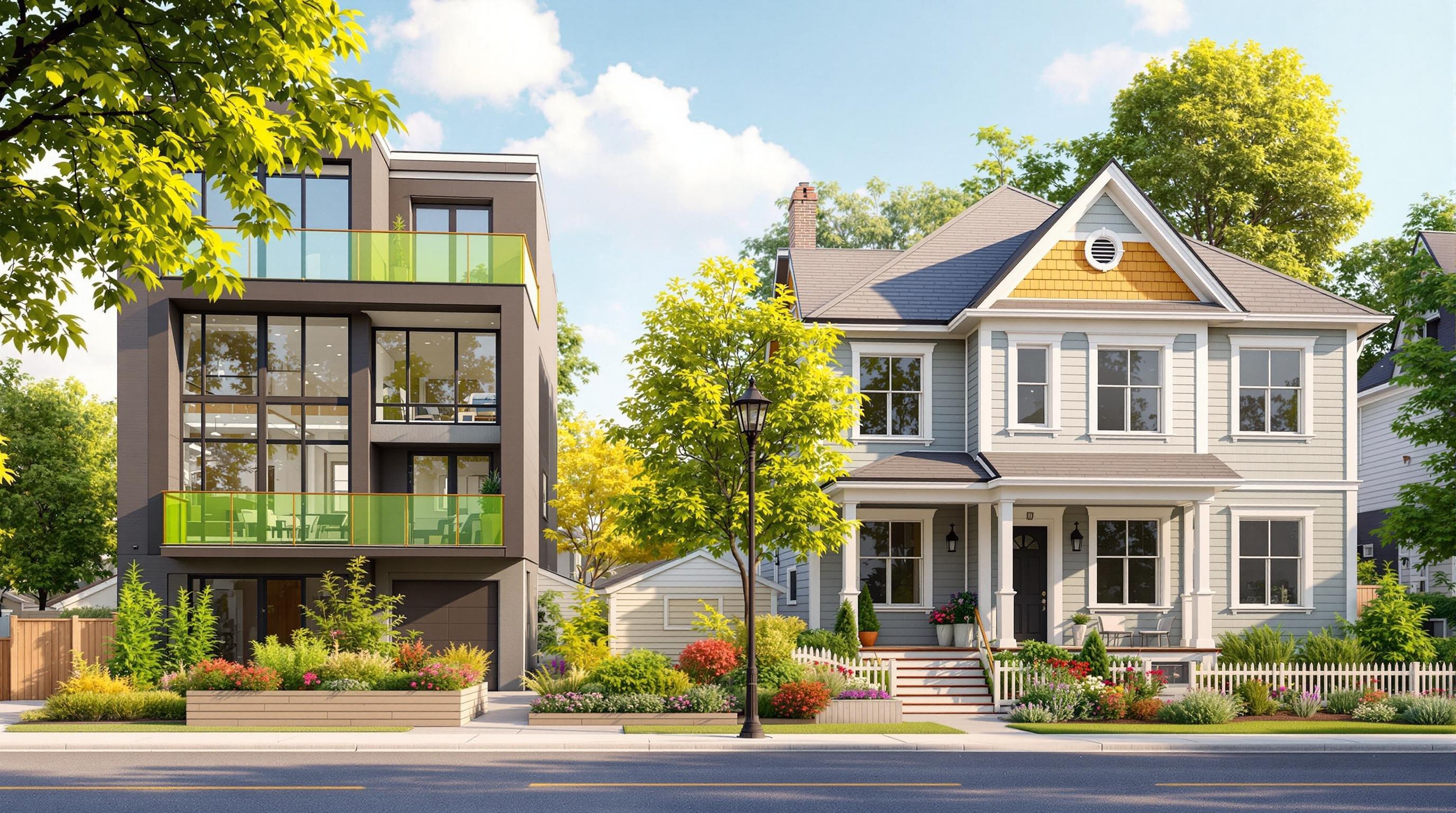Rent control policies in Nova Scotia differ significantly between urban areas like Halifax Regional Municipality (HRM) and smaller towns. Here’s a quick summary:
-
Halifax (HRM):
- Rent cap: 5% annual increase (effective January 2024 through December 2027).
- Average rent: $1,707 for a two-bedroom apartment, higher than the national average.
- Vacancy rate: Improved to 2.1% in 2024, but affordable units remain scarce.
- Market trends: Luxury apartments face reduced demand; affordable housing remains tight.
-
Smaller Towns:
- Rent cap: Same 5% annual increase applies.
- Housing challenges: Shortages, aging housing stock, and fewer new developments.
- Landlord struggles: Rising costs (e.g., property taxes, utilities) and tighter profit margins.
Quick Comparison
| Factor | HRM (Halifax) | Smaller Towns |
|---|---|---|
| Rent Cap | 5% annual increase | 5% annual increase |
| Average Rent (2BR) | $1,707 | Lower than HRM |
| Vacancy Rate | 2.1% (2024) | Varies, often lower |
| New Developments | High (4,657 starts in 2023) | Limited |
| Landlord Challenges | High costs, tenant turnover | Rising costs, low rents |
Main Insight
HRM benefits from stronger demand and more construction, but affordable housing is still a challenge. Smaller towns face housing shortages, fewer new developments, and financial strain on landlords. Tailored strategies are needed to address these regional differences.
Real estate boom in Halifax hurting renters and homeowner hopefuls
1. HRM Rent Control Guidelines
Halifax Regional Municipality (HRM) has implemented a rent control system to address the housing challenges in Nova Scotia's largest urban area.
The system uses a tiered approach: rent increases are capped at 2% until December 31, 2023, and then rise to a 5% annual cap from January 1, 2024, through December 31, 2027 [2][5]. This approach aims to balance tenant protections with landlords' financial considerations. For context, the average rent for a two-bedroom apartment in Halifax is $1,707 - significantly higher than the national average of $1,447 [7].
The rules differ based on tenancy type:
| Tenancy Type | Rent Control Applies? | Maximum Increase |
|---|---|---|
| Lease Renewals | Yes | 5% (from Jan 2024) |
| Fixed-term Extensions | Yes | 5% (from Jan 2024) |
| New Tenants | No | No limit |
| Mobile Home Parks | No | Separate regulations |
Halifax's vacancy rate reached 2.1% in 2024 - the first time it exceeded 1% in four years [7]. However, more affordable rental segments still face extremely low vacancy rates, often below 1%.
For landlords, rental income remains critical, with over 97% of revenues tied to rent [4]. When units turn over to new tenants, rents have increased by roughly 28% [7], highlighting the gap between controlled and uncontrolled rent adjustments.
"Existing tenants couldn't afford to move. It makes for a portion of the market where because people are staying and not moving, there's not a lot of change in tenants and the demand is still very strong there." - Lukas Jasmin-Tucci, CMHC economist for the Halifax area [7]
Overall, rent growth in Halifax has slowed, dropping from 11% to 3.8% in 2024 [7]. Luxury apartments are seeing reduced demand, prompting landlords to offer perks to attract tenants. Meanwhile, affordable units remain nearly fully occupied [7].
Halifax accounts for 87% of Nova Scotia's $700M rental investment as of 2019 [3]. These regulations have shifted investor priorities toward cost management and long-term property value over quick profit gains [6].
Next, we’ll explore how policies in smaller towns differ from HRM’s and how they shape local rental markets.
sbb-itb-16b8a48
2. Small Town Rent Control Measures
While Halifax leads Nova Scotia's rental market, smaller towns face their own set of challenges under the province-wide rent control framework. Municipalities like Cape Breton Regional Municipality (CBRM) provide a glimpse into how these regulations affect less urbanized areas.
Nova Scotia's 5% rent cap is in place until December 31, 2025 [12]. However, the dynamics in smaller towns differ significantly. For instance, CBRM is grappling with a housing shortage of about 1,000 units - a gap that could double within the next decade [1]. Even though rents in these areas are generally lower, affordability and availability remain pressing concerns.
Key Differences Between Small Towns and HRM
- Rental Increases: Over a three-year period, some small towns have seen rental rates climb by approximately 21.6% [11].
- New Construction: In 2019, Halifax added 4,020 new rental units [3]. Smaller towns, by contrast, have far fewer developments.
These differences highlight the unique struggles faced by landlords in smaller communities.
Small-town landlords often feel the strain of the 2% rent cap, as Gillian Ansell explains:
"What can you do when the government imposes a 2% rent cap and subsequently drives [expenses] up all across Nova Scotia when the cost of oil, power, property taxes, mortgage rates, everything else has increased by way more than 2%? And a landlord isn't even allowed to impose a reasonable increase?" [8]
This cap is especially taxing for rural landlords, who typically operate with tighter margins. According to the Investment Property Owners Association of Nova Scotia (IPOANS), smaller rental operators are particularly vulnerable because operating costs can eat up a larger share of income in areas with lower rents [3].
Municipal officials in rural Cape Breton have also acknowledged the growing challenges related to housing and homelessness [1]. With urban centers attracting most of the population, smaller communities often lack the resources to address these issues effectively.
Strategies for Small-Town Landlords
To navigate these challenges, landlords in smaller towns can focus on:
- Installing energy-efficient upgrades to reduce long-term costs.
- Performing regular preventive maintenance to avoid costly repairs.
- Using property management software for rent collection and upkeep tracking.
- Taking advantage of tax benefits like mortgage interest deductions and depreciation allowances [11].
While Halifax benefits from a steady influx of new rental units, smaller towns face an uphill battle. Aging housing stock in rural areas often requires significant maintenance, further complicating the situation for landlords and tenants alike.
Cost-Benefit Analysis
Let's dive into the financial impact of Nova Scotia's rent control policies on HRM and small towns. These measures influence property owners' returns and tenant costs differently, with clear distinctions in market performance and operational challenges.
Market Performance Indicators
Rental markets in HRM and rural areas show stark contrasts. In Halifax, the rental market remains tight despite rent control, with a vacancy rate below 1% [9]. Meanwhile, construction costs in HRM are about $116,000 higher than in rural Nova Scotia [3].
Rising operational costs are another hurdle. Insurance premiums, for example, have jumped by an average of 40%, with older buildings seeing increases as high as 80% [13]. These rising expenses hit small-town landlords harder, as they often operate with narrower profit margins.
Investment Returns Analysis
Data from the Investment Property Owners Association of Nova Scotia highlights how rent control impacts urban and rural markets differently. Take Killam Apartment REIT, which oversees more than 6,000 units across Nova Scotia [3]. Here's a quick comparison:
| Metric | HRM | Small Towns |
|---|---|---|
| Vacancy Rate | <1% | Varies by region |
| New Unit Construction (2019) | 4,020 units | Limited development |
This table illustrates the uneven market dynamics, with HRM benefiting from stronger demand and development activity compared to smaller communities.
Regional Market Dynamics
Halifax stands out nationally, leading Canadian cities in the construction of purpose-built rental apartments per capita [3]. However, this growth hasn't extended to smaller towns, where housing shortages remain a pressing issue. While Nova Scotia's rental market has seen rents rise 22.8% since 2000 - equating to an average annual increase of 1.14% [3] - smaller regions still face financial and housing challenges.
"Academic research studies show rent control exasperates housing supply shortages due to lack of new rental buildings and units coming onto the market" [13].
Operating Cost Considerations
Operational expenses further highlight the differences between urban and rural investments. In HRM, higher property values and operating costs are offset by strong rental demand and economies of scale. Urban areas also benefit from better access to services, which supports higher rents. In contrast, rural properties come with lower acquisition costs but face challenges like maintaining older buildings and limited rent potential.
Conclusion
The comparison above highlights how rent control policies affect markets differently across regions. In HRM, vacancy rates increased from 1.0% to 2.1% [14], creating a more competitive environment for investors. The average monthly rent stands at $1,538 [14], and the rent control measures - capped at 5% annually - will remain in place through December 31, 2025 [10]. These policies provide clear guidelines for investment planning.
Urban and rural markets show stark differences. Halifax reported 4,657 housing starts in 2023, marking a 37.5% rise from the previous year [14]. In contrast, rural areas struggle with a lack of new developments, highlighting a critical gap in housing supply.
Key Market Factors
| Market Factor | HRM Impact | Small Towns Impact |
|---|---|---|
| Rent Cap | 5% annual increase limit | 5% annual increase limit |
| Housing Demand | Strong (2.1% vacancy) | Variable, with notable shortages |
| Construction Activity | High (4,657 starts in 2023) | Limited new developments |
These factors emphasize the need for tailored approaches based on location.
For HRM, strategies should focus on improving operational efficiency and retaining tenants, especially under the constraints of the rent cap. In smaller towns, investors face challenges like limited rent growth and scarce new developments, requiring extra caution and planning.
Beyond the numbers, social concerns remain a pressing issue. Kevin Russell highlighted this in his statement:
"Since the introduction of rent control, homelessness has gone up in Nova Scotia. We warned politicians when they legislated rent control in the fall of 2021 that it would increase homelessness" [4].
These dynamics underline the importance of location-specific strategies. While HRM leads in construction and rental demand, rural areas present different opportunities and challenges for those considering investments outside urban centers.
Related Blog Posts
- 7 Ways to Maximize Rental Income with Multi-Unit Properties in Nova Scotia
- Vacation Rental Laws in Halifax, Nova Scotia: Short-Term vs. Long-Term Investment Prospects
- A Landlord’s Guide to Rent Control in Nova Scotia: Key Rules & Opportunities
- Demographic Tides: Analyzing Youth Migration & Retirement Inflow in Nova Scotia’s Housing Market



